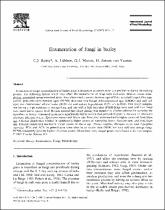JavaScript is disabled for your browser. Some features of this site may not work without it.
- ResearchSpace
- →
- Research Publications/Outputs
- →
- Journal Articles
- →
- View Item
| dc.contributor.author |
Rabie, CJ

|
en_US |
| dc.contributor.author |
Lubben, A

|
en_US |
| dc.contributor.author |
Marais, GJ

|
en_US |
| dc.contributor.author |
Jansen van Vuuren, H

|
en_US |
| dc.date.accessioned | 2007-02-06T13:25:38Z | en_US |
| dc.date.accessioned | 2007-06-07T10:07:46Z | |
| dc.date.available | 2007-02-06T13:25:38Z | en_US |
| dc.date.available | 2007-06-07T10:07:46Z | |
| dc.date.copyright | en_US | |
| dc.date.issued | 1997-04-01 | en_US |
| dc.identifier.citation | Rabie, CJ, et al. 1997. Enumeration of fungi in barley. International Journal of Food Microbiology, vol. 35(2), pp 117-127 | en_US |
| dc.identifier.issn | 0168-1605 | en_US |
| dc.identifier.uri | http://hdl.handle.net/10204/1550 | en_US |
| dc.identifier.uri | http://hdl.handle.net/10204/1550 | |
| dc.description.abstract | Estimation of fungal contamination of barley grain is important as certain fungi can proliferate during the malting process. The following factors which may affect the enumeration of fungi were evaluated: dilution versus direct plating, pre-soaked versus unsoaked grain, five culture media: potato dextrose agar (PDA), acidified Czapek-Dox agar (ACA), pentachloronitrobenzene agar; (PCNB) dichloran rose bengal chloramphenicol agar (DRBC) and malt salt agar; two disinfectants' ethanol/water (80:20 v/v) and sodium hypochlorite (3.5% w/v in H2O). Two barley samples, one having a high incidence of storage fungi and one with a high incidence of field fungi were used and most fungi were identified to species level. Results showed that direct plating was superior to dilution plating for assessing the mycoflora of barley. Unsoaked grain gave significantly higher counts than pre-soaked grain in the case of Alternaria alternata, Rhizopus oryzae, Epicoccum nigrum and Mucor spp. Pre-soaked grain resulted in higher counts of Penicillium spp. Chlorine disinfection resulted in significantly higher counts of Aspergillus flavus, Eurotium spp. and Penicillium spp. Ethanol disinfection resulted in higher counts of Mucor spp., Phoma sorghina, Rhizopus oryzae and Aspergillus restrictus. PDA and ACA, in general gave some what better results than DRBC for both field and storage fungi. PCNB consistently gave the highest Fusarium counts. More than thirty fungal genera were found in the two samples. | en_US |
| dc.format.extent | 696102 bytes | en_US |
| dc.format.mimetype | application/pdf | en_US |
| dc.language.iso | en | en_US |
| dc.publisher | Elsevier Science BV | en_US |
| dc.rights | Copyright: 1997 Elsevier Science B.V. | en_US |
| dc.source | en_US | |
| dc.subject | Barley | en_US |
| dc.subject | Microbiology | en_US |
| dc.subject | Fungal contamination | en_US |
| dc.title | Enumeration of fungi in barley | en_US |
| dc.type | Article | en_US |
| dc.identifier.apacitation | Rabie, C., Lubben, A., Marais, G., & Jansen van Vuuren, H. (1997). Enumeration of fungi in barley. http://hdl.handle.net/10204/1550 | en_ZA |
| dc.identifier.chicagocitation | Rabie, CJ, A Lubben, GJ Marais, and H Jansen van Vuuren "Enumeration of fungi in barley." (1997) http://hdl.handle.net/10204/1550 | en_ZA |
| dc.identifier.vancouvercitation | Rabie C, Lubben A, Marais G, Jansen van Vuuren H. Enumeration of fungi in barley. 1997; http://hdl.handle.net/10204/1550. | en_ZA |
| dc.identifier.ris | TY - Article AU - Rabie, CJ AU - Lubben, A AU - Marais, GJ AU - Jansen van Vuuren, H AB - Estimation of fungal contamination of barley grain is important as certain fungi can proliferate during the malting process. The following factors which may affect the enumeration of fungi were evaluated: dilution versus direct plating, pre-soaked versus unsoaked grain, five culture media: potato dextrose agar (PDA), acidified Czapek-Dox agar (ACA), pentachloronitrobenzene agar; (PCNB) dichloran rose bengal chloramphenicol agar (DRBC) and malt salt agar; two disinfectants' ethanol/water (80:20 v/v) and sodium hypochlorite (3.5% w/v in H2O). Two barley samples, one having a high incidence of storage fungi and one with a high incidence of field fungi were used and most fungi were identified to species level. Results showed that direct plating was superior to dilution plating for assessing the mycoflora of barley. Unsoaked grain gave significantly higher counts than pre-soaked grain in the case of Alternaria alternata, Rhizopus oryzae, Epicoccum nigrum and Mucor spp. Pre-soaked grain resulted in higher counts of Penicillium spp. Chlorine disinfection resulted in significantly higher counts of Aspergillus flavus, Eurotium spp. and Penicillium spp. Ethanol disinfection resulted in higher counts of Mucor spp., Phoma sorghina, Rhizopus oryzae and Aspergillus restrictus. PDA and ACA, in general gave some what better results than DRBC for both field and storage fungi. PCNB consistently gave the highest Fusarium counts. More than thirty fungal genera were found in the two samples. DA - 1997-04-01 DB - ResearchSpace DP - CSIR KW - Barley KW - Microbiology KW - Fungal contamination LK - https://researchspace.csir.co.za PY - 1997 SM - 0168-1605 T1 - Enumeration of fungi in barley TI - Enumeration of fungi in barley UR - http://hdl.handle.net/10204/1550 ER - | en_ZA |






